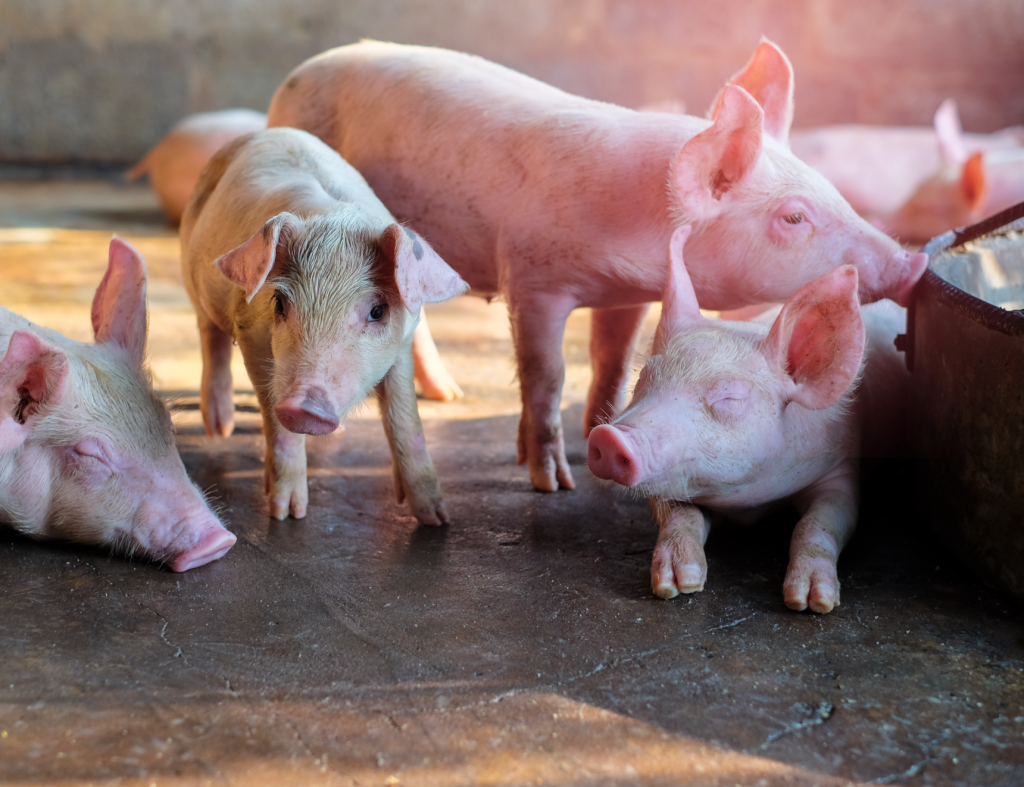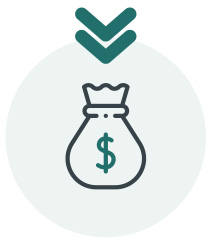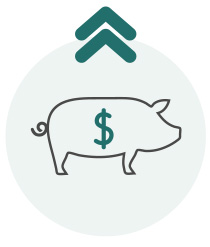
Clostridium and E.coli
Disease
The main causes of diarrhea (scours) in piglets are: E. coli, clostridium, coccidia, TGE virus, porcine epidemic diarrhea virus, and rotavirus E. coli is the most common.1
These bacteria occur in sow faeces. Piglets intake them via their snout and then they infect the intestine. Infection with both pathogens can produce fatal enteritis, which is clinically characterized not only by diarrhea, but also by dehydration, weakness and in severe cases, death.
Infection is most common in piglets younger than 5 days of age. At weaning, the loss of milk intake and IgA, the expression of new intestinal receptors and intestinal irritation due to change in diet (liquid milk based to dry plant protein), allows E. coli to adhere to the small intestine villi, and its toxins cause acute diarrhea, 5 to 14 days after weaning.

Economic impact
Clostridium and E. coli-related neonatal scours in piglets can reduce profit by 30% due to increased mortality, slower growth rate and the additional cost of buying antibiotics. Infected farms see an increase of in the cost per piglet.2

Profit
30%

Cost per Pig
$1.29
Diarrhea was estimated to account for a reduction in ADWG by 8–14 g/day in the first week of life (in studies conducted in Sweden and Denmark).
Costs caused by neonatal diarrhea can vary considerably depending on the severity of disease:
- Using production data from 2010, the estimated costs for Swedish herds affected by neonatal diarrhea with a mortality of 10% was as high as 134€ per sow per year.

Prevalence
Neonatal diarrhea can be one of the most common diseases in piglets.
In severe outbreaks, mortality can rise to over 7%.3
If untreated, mortality can reach 100% in individual litters.2
The average neonatal diarrhea morbidity is 30–40% but may be as high as 80% in some herds, and mortality can reach 70% in affected litters (5–24% of the overall preweaning mortality in Swedish and Dannish studies).**
E. coli disease.

Diagnosis
The diagnosis of neonatal diarrhea includes the combination of different diagnostic procedures, but necropsy and sample submission to a diagnostic laboratory is necessary to confirm the causative agent/s involved.
Visible symptoms of infection are:
- Watery / creamy diarrhea (scour)
- Wet skin around the rectum and tail
- Huddling of piglets together / shivering
Diagnosis can be carried out by:
- Analysis of a rectal swab or faecal sample to detect bacteria
- Using litmus paper (E. Coli will result in alkaline scour and turn paper
blue, whilst viral infections result in acidic scour and turn paper red) - Post-mortem examination

Treatment and prevention
Both E.coli and Clostridium bacteria are soil and faecal borne, therefore cleaning and hygiene are very important to kill the bacteria and spores that cause neonatal diarrhea.
Once diarrheal disease has begun, treatments often include antibiotics and supportive therapy in piglets (supply electrolytes in the water to avoid dehydration and maintain electrolytes equilibrium in the body).
Faeces must be removed from farrowing stalls and stalls cleaned thoroughly. The bacteria can also live on the sow’s skin, so cleaning them before moving them to the farrowing stall is recommended. Staff should take care to clean their hands and footwear, and infected piglets should be treated last, to prevent transmission to healthy litters.
Farms should also ensure piglets receive an adequate and early intake of colostrum, which contains high amounts of maternally derived antibodies.
1. Diseases manual. Colibacillosis. Pig333.com
2. Mohr, M. Economic Impact of E. coli and Clostridia Disease in Piglet
3. E. coli disease. The Pig Site.
Download the disease infographic
MSD Animal Health solutions to control Clostridium and E.coli

SowCare: Porcilis® ColiClos
SowCare: Porcilis® ColiClos is an inactivated vaccine for the active immunisation of sows and gilts to provide passive immunity of their piglets against E. coli and Clostridium perfringens type C.
SOLUTIONS
Porcilis® ColiClos
Inactivated vaccine to provide passive immunity of piglets against E. coli and C. perfringens type C


BENEFITS
- Single 2ml injection, double protection
- Develops maternally derived antibodies to be passed through the colostrum and milk
- Reduces mortality and clinical signs caused by E. coli expressing F4ab, F4ac, F5 or F6 factors and C. perfringens type C.
HOW TO USE IT
- Two doses of 2ml, first dose given 6 to 8 weeks before farrowing, booster dose given 4 weeks later.
- Revaccination annually 2 to 4 weeks before the expected date of farrowing.

SowCare:
Other related vaccines
Porcilis® Porcoli DF
ProSystem® RCE



